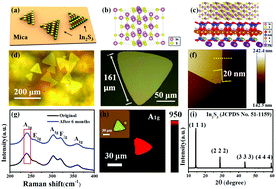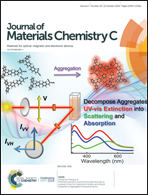Epitaxial growth of large-scale In2S3 nanoflakes and the construction of a high performance In2S3/Si photodetector†
Abstract
MoS2-like layered 2D materials have attracted attention worldwide due to their intriguing material properties. In contrast, it is still a great challenge to prepare non-layered 2D materials that may provide unique electronic and optoelectronic properties compared to layered materials. As an emerging IIIA–VIA semiconductor, In2S3 shows great potential for application in optoelectronics. Herein, ultrathin non-layered In2S3 nanoflakes, with uniform thickness and lateral size reaching the sub-millimeter scale, are synthesized on mica substrates via a simple physical vapor epitaxy method. Then, a photodetector based on an In2S3/Si heterojunction is fabricated. Owing to the strong light–matter interactions of In2S3 and the built-in potential at the In2S3/Si interface, which accelerates the separation of photoexcited electron–hole pairs, the device exhibits a broadband sensitivity covering the visible to near-infrared region. The responsivity, detectivity and rise/decay time are 579.6 A W−1, 2 × 1011 Jones and 9/0.131 ms, respectively. These performance metrics are among the best values when compared with those of reported layered 2D materials/Si heterojunction photodetectors. Notably, the In2S3/Si photodetector suffers from negligible performance degradation even after 1050 cycles of operation or 6 months of exposure to air. These findings broaden the scope of 2D materials and highlight that In2S3 nanoflakes hold great potential for further optoelectronic applications.



 Please wait while we load your content...
Please wait while we load your content...